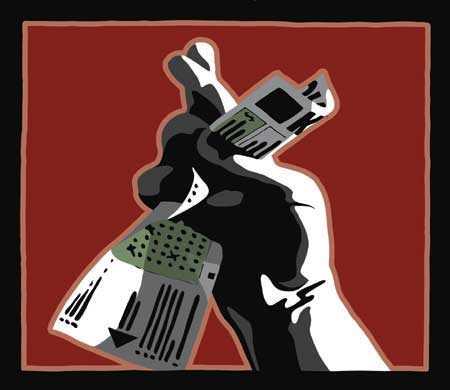By Tyler J. Jarvis, ’89, and Heidi Baumann Jarvis, ’89
 Many arguments against gambling have been made, and they usually center around the negative consequences that result from gambling, including greatly increased crime, the destruction of family and society, and the problems that result from compulsive and pathological gamblers. Although these are serious issues, one that is seldom raised is people’s misunderstanding of the basic nature of gambling: odds. Although most people believe they understand odds and the risks involved in gambling, generally they do not. And their confusion about risks, along with other misunderstandings and biases, makes it easy for gambling providers to manipulate and defraud them.
Many arguments against gambling have been made, and they usually center around the negative consequences that result from gambling, including greatly increased crime, the destruction of family and society, and the problems that result from compulsive and pathological gamblers. Although these are serious issues, one that is seldom raised is people’s misunderstanding of the basic nature of gambling: odds. Although most people believe they understand odds and the risks involved in gambling, generally they do not. And their confusion about risks, along with other misunderstandings and biases, makes it easy for gambling providers to manipulate and defraud them.
COSTS TO SOCIETY
It is well established that crime rates rise substantially when gambling is legalized. Since some communities in Mississippi legalized casino gambling, their crime rate has increased at least 800 percent,1 with rapes increasing 200 percent and robberies 218 percent.2 And in 1994 one study showed that communities with gambling had nearly twice the national crime rate.3
Not only does legalized gambling increase local crime, it destroys individuals and families. Gambling is often addictive, and many people who gamble become problem or compulsive gamblers. In Iowa, after gambling was legalized, the number of compulsive gamblers rose from 1.7 to 5.4 percent of the population.4 And states with legalized gambling can expect fully 10 percent of their population to develop the slightly milder but still serious condition of being “problem gamblers.”5 Compulsive and problem gambling tends to destroy the gambler’s family emotionally as well as financially, as income, belongings, and even groceries are sacrificed to the insatiable desire to win.
Yet despite these facts, gambling is growing throughout the world. In the United States in 1974, when the only legal gambling was in Nevada, the amount of money wagered legally was about $17.3 billion. In 1995 the estimated amount of money wagered was a huge half trillion.6 The problem is common in Europe, as well. Even Albania and Britain, the last European holdouts against state-run lotteries, finally succumbed and instituted lotteries in 1993 and 1994, respectively.7
Why is gambling so popular in spite of its destructive consequences? This is a question for which there are few satisfactory answers, but it seems that one of the biggest problems is misunderstanding. Although many people are aware of the moral and religious arguments against gambling, and some are also aware of the economic and social costs, three other key issues are less often discussed. First, most of us do not understand just how bad the odds are. Second, other misunderstandings interfere with our ability to use the odds. And third, casinos, lotteries, and other gambling providers manipulate these misunderstandings to entice and exploit gamblers. By learning about the odds and examining the misunderstandings, we can counter all three of these problems. In fact, research shows that the more people learn, the less likely they are to gamble.8
UNBEATABLE ODDS
Almost everyone has trouble understanding the huge and tiny numbers involved in gambling odds. The main thing to understand is that the odds always favor the house. For example, the house’s take on a slot machine is about 35 percent. This means that if you bet $10, you can expect to walk away with $6.50; if you bet $100, you can expect to keep only $65, and so forth. The more you play, the more you lose. Although some gamblers are ahead temporarily, in the long run the odds will prevail. This simple principle explains why the casinos take in so much money. In fact, in 1996 annual casino revenue in the USA was $22.8 billion.9
The odds for lotteries are even worse than for casinos. The Minnesota State Lottery, for example, pays out only 60 percent of the money it takes in—substantially worse than slot machines or any other type of casino gambling. And the chances of winning the $5,000 jackpot in the Minnesota scratch-off lottery are approximately one in 240,000. You are eight times more likely to die from a lightning strike than to win this jackpot.10
Bigger jackpots have still worse odds. The chances of winning the California Lotto Jackpot are approximately one in 14 million. If you have to drive 10 miles to buy a ticket, you are three times more likely to be killed in an automobile accident on the way than to win the jackpot.11 Large multistate lotteries like the Powerball have the worst odds, and they are almost nonexistent. Chances of winning are worse than one in 54 million.
The fact that nearly 25 percent of all U.S. citizens have a weekly lottery habit12 shows that far too few people understand these odds. For example, people may wonder, “What if you’re that one?” even though they would never bet on the much more likely chance that they would be struck by lightning. Lottery odds are so small as to be essentially zero. Or as Fran Lebowitz supposedly said, “As I figure it, you have the same chance of winning the lottery whether you play or not.”
MISUNDERSTANDINGS, BIASES, AND MISTAKEN BELIEFS
Even when we know the odds, we still have misunderstandings, false ideas, and other biases that interfere with our ability to understand how the odds apply to our situation. People often mistakenly believe that they will be able to beat the odds in some way.
The Gambler’s Fallacy
One of the easiest mistakes to make is thinking that past gambles influence future ones. This is sometimes called the “gambler’s fallacy,” and it leads people to bet more money and to bet more often than they otherwise would. For example, many people know how to figure that there is only a 1-in-16 chance that a fair coin will come up heads four times in a row.13 But if the coin has already come up heads three times in a row, then the chances that it will do so a fourth time are the same as they would be if it had never been tossed before—1 in 2. However, it is easy to think that this coin has only a 1-in-16 chance of coming up heads. It seems that the coin should make the average of tosses “come out right.” But the coin does not remember past tosses and feels no obligation to even out the number of heads and tails. Misunderstanding this fact leads gamblers to believe they have more information than they really do, causing them to be more willing to gamble.
Systems
Similar misunderstandings about numbers and odds are used to devise schemes for picking lottery numbers, roulette numbers, or other gambles, and for deciding when and how much to bet. One elaborate system depends on a faulty argument about distributing even and odd numbers. Other systems try to reproduce the techniques of lottery drawings or figure odds from past numbers (the gambler’s fallacy again). Although these systems sound impressive, none of them really improves a gambler’s chances. The systems not only encourage gambling by making people believe that their odds of winning are higher, but they also encourage gamblers to waste additional money buying the systems.

Although gambling is trying to make itself over as a harmless form of entertainment, in reality it is a manipulative and destructive method for exploiting people’s weaknesses.
Availability Error
Another mistake which increases people’s tendency to gamble is called “availability error” by psychologists.14 This is the common tendency to focus only on good, unusual, or easily remembered experiences, forgetting the bad, common, or less available ones. For example, hearing that someone has won the lottery sticks in our minds more than hearing that someone has lost the same lottery. We remember winners more than losers, and we mistakenly think that the chances match our memory. This explains why people put more money into slot machines that are in large groups, where they can see others winning, rather than into lone machines where they have no recent memory of someone’s winning.
We may also think that if we have heard of a winner it must not be very hard to win. Many people have a story about how their Aunt Velda or their brother-in-law’s boss’s friend once won the jackpot in the lottery or a slot machine. But such stories omit several things. Most important is the fact that Aunt Velda lost thousands of dollars in the slot machines and lotteries both before and after winning her $100 “jackpot.” Many so-called “jackpots” are really only small prizes which entice people to continue playing. They take advantage of our tendency toward availability error and exploit our memory of the one “win” while encouraging us to forget the many losses.
Luck
The last in the list of misunderstandings is the gambler’s mistaken belief in “luck.” The research of psychologist Willem Wagenaar shows that many people believe that chance and luck are different things.15 People trust a lucky number, a lucky rabbit’s foot, or some other lucky thing to make them rich. In reality, most gambles are determined entirely by chance, with no influence of skill or luck. Yet greed makes us believe that there are moments when the universe wants to make us richer.
This belief in luck shows that parents and schools have failed to teach the basic truths necessary to avoid fraud. Belief in luck makes gamblers susceptible to deception and manipulation by lotteries, casinos, racetracks, and other gambling establishments.
Many members of the LDS Church may not be so naïve as to believe in “luck,” per se. But they harbor a similar belief that is just as dangerous for their finances; namely, they believe that God wants to help them become rich, and quickly. Maybe that is because they intend to use the money for good, or even just because they are trying to keep the commandments and believe that He wants to reward them with happiness (or rather money). This is a big mistake.
GAMBLING AS MANIPULATION
Although gambling is trying to make itself over as a harmless form of entertainment, in reality it is a manipulative and destructive method for exploiting people’s weaknesses. Gambling providers, including state-run lotteries, manipulate people’s misunderstandings about gambling to lead them to wager and lose more money.
Casinos have researched every conceivable technique they might apply to induce the gambler to stay longer and bet more. One casino found that they could substantially increase the amount wagered in slot machines by blowing certain perfumes into the air around the machines.16 Others carefully track which colors of slot machines are most likely to attract players initially, and then which colors people prefer as they become more engaged, locating the different colored machines in such a way as to encourage people to move gradually into the center where they will stay longer. They also found that placing one or two machines with generous odds in a large group of machines motivated people to search madly for the “good” machines by playing every machine they could. And similar principles in psychology have taught them to make each machine have many small payoffs, often less than was originally bet, to encourage players to keep trying for the big win, and to make them think they are close.17
Gambling chips themselves are a subtle manipulation to make gamblers feel like they are not losing actual money. One casino manager points out that the average person thinks of cash in terms of what it will buy, but chips are just “betting units.”18
Unfortunately, government lotteries are doing some of the same things. Not only do they promote gambling, they even sink to the same sorts of tricks that casinos use to manipulate gamblers. One especially reprehensible trick used by casinos in Nevada was the “near miss” slot machine, which made the losing combinations appear to be close to a large jackpot, giving the illusion that the gambler had almost won. This trick was eventually banned by Nevada gambling authorities19·, yet almost every lottery employs a similar trick. Namely, you would rarely think you were close to winning if you were supposed to pick a number between one and 18 million, so instead lotteries have players choose many small numbers. They then give small prizes for partial matches, thereby strengthening the illusion that players are close to winning and encouraging them to try again. In reality, being close last time has absolutely nothing to do with how gamblers will do in the future, but the lottery encourages them to think it does. State governments, whose duty is to protect citizens from exploitation, are actually taking part in it by promoting their own lotteries.
CONCLUSION
One of the main arguments used in favor of legalizing gambling and instituting lotteries is that the resulting tax revenue can be used for good purposes—schools, for example. The most obvious flaw with this argument is that in many cases the indirect costs of gambling, such as increased crime and lost productivity, actually cost the state more than it gains in increased tax revenue.
A second flaw is that using gambling money to fund worthy programs creates perverse incentives and conflicts of interest. A significant example of this is the funding of public education with lottery revenues. Public educators’ duty is to teach citizens, among other things, about mathematics, including probability. But if they taught their students well, there would be no lottery revenues because no one would play. So we are rewarding them for failing to teach effectively.
But the most important flaw in the argument for legalized gambling is the simple fact that good ends do not justify dishonest or immoral means. No legitimate government would legalize theft or fraud in order to increase tax revenues; why, then, do they permit gambling?
We know that gambling’s philosophy of something-for-nothing undermines the framework of our society. But we also need to remember that gambling’s something-for-nothing is a lie. Both gamblers and the communities that vainly hope to benefit will find instead that gambling is nothing-for-something. We have an obligation not only to avoid gambling ourselves, but also to teach the truth about gambling to others, and to use what we know to change attitudes, perceptions, and laws about gambling in our communities and nations.?*
A version of this article was previously published as “Gambling: A Lie and a Snare,” in D. Paul and G. Hatch, eds., Enter to Learn, (English Composition, BYU, 1999), pp. 288–99.
More information is available on the authors’ Web site (https://www.math.byu. edu/~jarvis/gambling.html).
REFERENCES
1. Stephanie Saul, “Gambling: The New National Pastime: Rural Renewal,” Newsday, Dec. 10, 1995, p. A7.
2. National Coalition Against Legalized Gambling, Crime Sheet 1998.
3. Joseph P. Shapiro, “America’s Gambling Fever,” U.S. News and World Report, Jan. 15, 1996, pp. 52, 57.
4. Iowa Department of Human Services, “Gambling and Problem Gambling in Iowa: A Replication Survey,” July 28, 1995, pp. 17, 31.
5. Charles T. Clotfelter and Philip J. Cook, “Selling Hope,” National Bureau of Economic Research (Boston: Harvard University Press, 1989), pp. 215–32.
6. E. M. Christiansen, S. Sinclair, and J. Liao, “The United States 1995 Gross Annual Wager,” International Gaming Wagering Business 1996, no. 17 (August 1996), pp. 53–92.
7. Richard McGowan, State Lotteries and Legalized Gambling: Painless Revenue or Painful Mirage (Westport, Conn.: Praeger, 1994), pp. 34–37.
8. See Reuven Brenner and Gabrielle A. Brenner, Gambling and Speculation (Cambridge University Press, 1990), p. 31.
9. Traci Watson, “Environmentalist lawsuits a bet against casinos,” USA Today, Aug. 2, 1999, p. 3A.
10. James Walsh, True Odds (Santa Monica, Calif.: Merritt Publishing, 1996), p. 16.
11. Michael Orkin, Can You Win? The Real Odds for Casino Gambling, Sports Betting and Lotteries (W.H. Freeman & Co., 1991), p. 105.
12. The Christian Science Monitor, “Gambling’s Illusiveness,” Jan. 19, 1994, p. 22.
13. Simply multiply the odds of getting heads with each toss.
14. See Daniel Kahneman, Paul Slovic, and Amos Tversky, eds., Judgment Under Uncertainty: Heuristics and Biases (Cambridge University Press, 1982).
15. Willem A. Wagenaar, Paradoxes of Gambling Behaviour (London: Lawrence Erlbaum, 1988), p. 93.
16. James Popkin, “Tricks of the Trade,” US News and World Report, Mar. 14, 1994, p. 48.
17. Ibid, pp. 49–50.
18. Ibid, p. 49.
19. Ibid, pp. 50–51.









